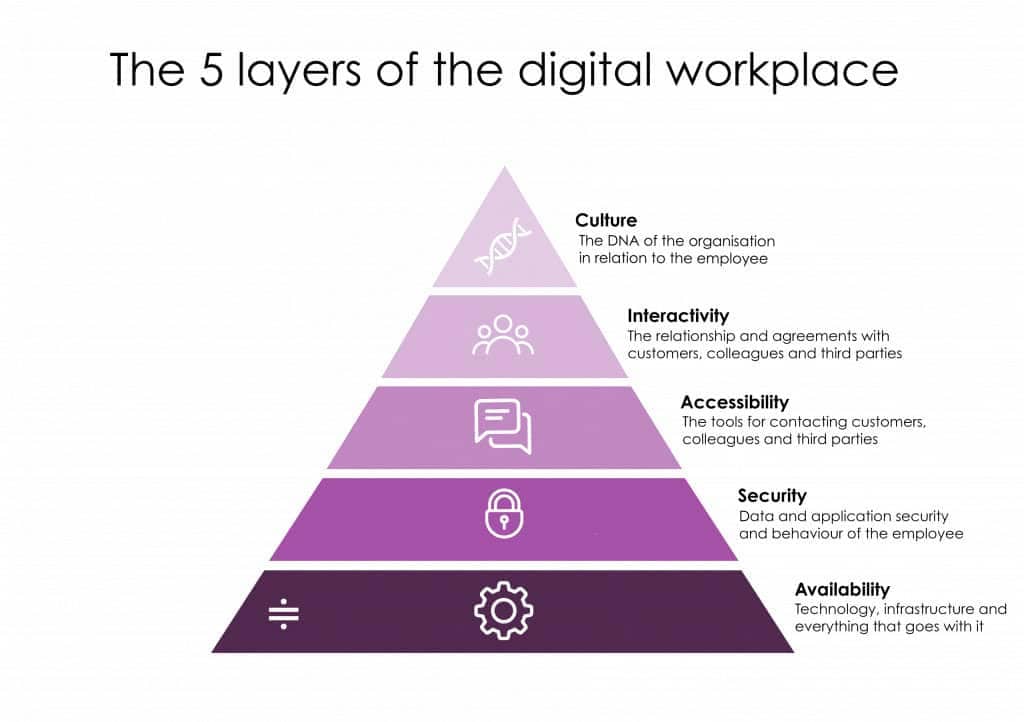
The 5 Layers of the Hybrid Workspace
The analogue coronavirus has made a huge impact on the way we work digitally. A lot has been said and written about telecommuting in recent years, and while sectors such as government, education and healthcare suffered cold feet, the corona crisis has shown that the technical side of the new world is ready to roll. In no time at all, everybody was working from home, even staff in organisations that had until March 16 never allowed it.m
Hybrid is here to stay
Now, six months later, it is becoming plain to see that telecommuting, or hybrid working as some call it, is here to stay. At the end of July, Dutch state news organisation NOS reported that large employers were entertaining scenarios in which they would not return to the workplace situation of before the crisis. Henk Volberda, professor of strategic management at the University of Amsterdam, said in the same article that he expected the more-at-home, less-at-the-office trend to continue. “The office is becoming more of a meeting place.”
It’s a trend we see at Solvinity, too. Many of our staff say they don’t really need to come to the office anymore to do their work. They like coming to work, but don’t feel it’s necessary to do so every day – or even every week. At the same time, they do miss the socials with colleagues: the corridor encounters and coffee-machine chats. Also, staff at Solvinity experience the transition between work and their private lives to be far more abrupt; gone are the days of commuting, the time they could use to gradually change their mindset. Indeed, many traditional boundaries between private and professional life have faded due to working from home and it’s affecting some more than others.
Working from home, then, is attractive and certainly here for keeps, but it has its pitfalls. Another of those is that if you roll out the technology, it does not follow that everybody will immediately embrace its full potential. Here, I believe, lies an important responsibility for employers: fill in the pitfalls, or at least cover them with a plank. In addition to facilitating the requisite technical infrastructure, employers are obliged to think about several other aspects of working from home.
The five layers of the workspace
Imagine a pyramid, the base layer of which represents the availability of the technical infrastructure of the workspace with all its bells and whistles.

On top of that base lies a security layer. How do you ensure that data and apps are secure? Another technical concern, but one that relies on behaviour to be effective. How do you persuade employees to take the utmost care with sensitive information? How do you prevent such information finding its way onto devices that are insufficiently protected?
The third layer is about accessibility. How do you ensure that everyone has access to all the information they need to do their job anytime, anywhere – at the office, at home and on the road? How do you ensure that employees can always effortlessly find all the tools and data they need and are always aware of the information that is relevant to them? A good workspace enables employees to do their work at their desk during the day, but also to easily continue working on their phone while traveling by train in exactly the same IT environment.
The fourth layer of the pyramid is formed by the social component. It is about how you interact and maintain a bond with colleagues, customers and third parties, but also about social intelligence, for example. How do you make contact with colleagues, customers and third parties: do you use video, or audio only? And if video, should the background be blurred? These things matter because they play a role in how your message is received. What policy should you adopt? Does everybody hit ‘quit’ right after an online meeting, or should there be some time for informalities?
The fifth and top layer of our pyramid, its pyramidion or capstone, encapsulates corporate culture, the DNA of a company in relation to employees. In a setting with sufficient social interaction, you can expect culture to rub off on staff. But can you still talk about commitment and employee loyalty if social interaction can no longer be taken for granted in the way it was before?
Pleasantly productive anywhere
Sure, Solvinity is first and foremost an IT service provider. Integral to our services portfolio is a modern cloud workspace environment, Lango Workspace, which offers organisations optimum technical solutions to the current developments. We keep workspaces available 24/7 and ensure robust data security. It’s what we’re good at. But we also know it’s about so much more than virtual desktops. It’s about user adoption, onboarding. And that requires training and education. And those require appropriate communication in terms of what staff can expect, and of do’s and don’ts. Not technology, but a process tailored to suit each new user group and that is different for all employers. We are fully aware of that – and we know the specialists who can help employers achieve the desired results.

Ultimately, the major issues concerning the workspace revolve around end-user productivity. How do you ensure that an employee can do their job in a way that strikes the right balance between work and private life, in a way that is secure and also promotes maximum productivity? Apart from the technical side of things, we as experts feel obliged to share our knowledge of the other aspects of the New World of Work that require attention if it is to be a success from the perspective of both employer and employee.
New home office
We’re going to do just that at our ‘New Home Office’ event on 29 September. In conjunction with 9292, first-out-of-the-box Lango user, and our consultancy partners Improven, we would be delighted to share the latest workspace trends with you. We will discuss best practices with respect to the new home office, and demonstrate how a cloud solution such as Lango Workspace can support this.
In the meantime, we’ll be getting to grips with our own partial return to the office. What layout will prove coronaproof? What about consultation structures and meetings? Should each department have a dedicated office day? Or is cross pollination to be preferred and should staff be encouraged to mix when working at the office? Only time, trial and error will tell what works best and what people feel most comfortable with. I’m looking forward to sharing our experiences with you at the end of September.
If you’d like to know more about the ‘New Home Office’, then please visit our website and let us know you’re coming!
If you’d like to know more about Lango Workspace, check it out at solvinity.com//lango-workspace.
Sign up for the Solvinity Newsletter
Receive the latest news, blogs, articles and events.
Subscribe to our newsletter.

More articles
More
Zero Trust: a practical mindset for effective digital security
Discover how the Zero Trust approach protects your organisation against future digital threats in this article.
Take Control of Your Security Strategy with the NIST Framework
Discover how the NIST Framework helps you structure your security approach and keep risks under control...
READ MOREWhat makes a Secure Managed Cloud truly ‘secure’?
What makes a Secure Managed Cloud truly ‘secure’? In an era where cyber threats are constantly...
READ MORE
